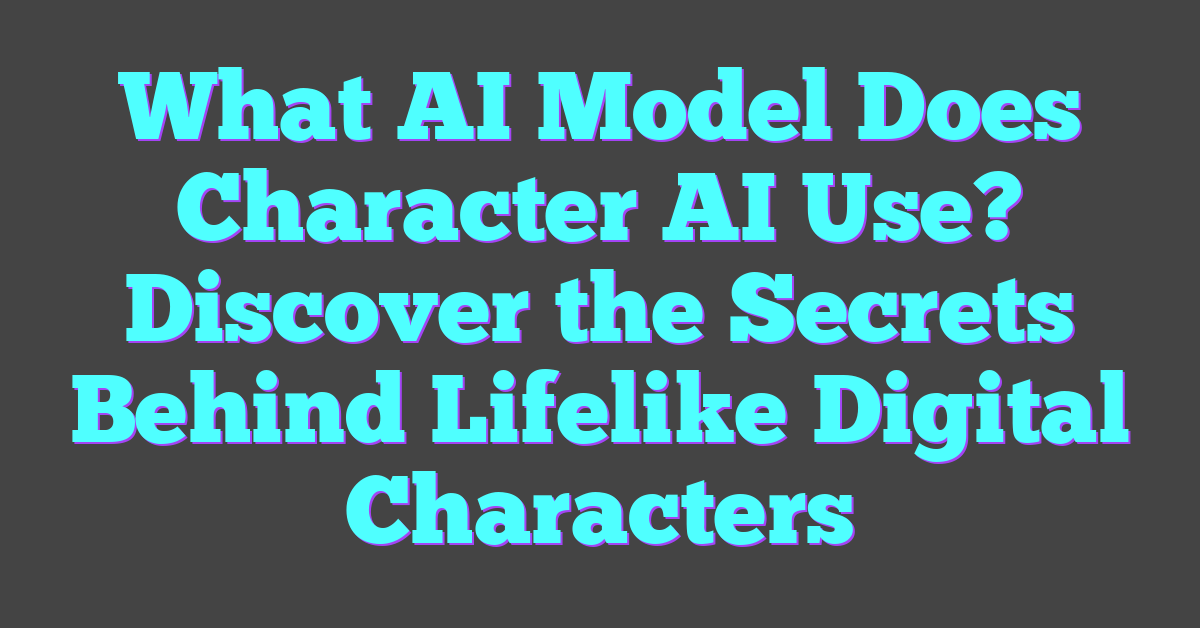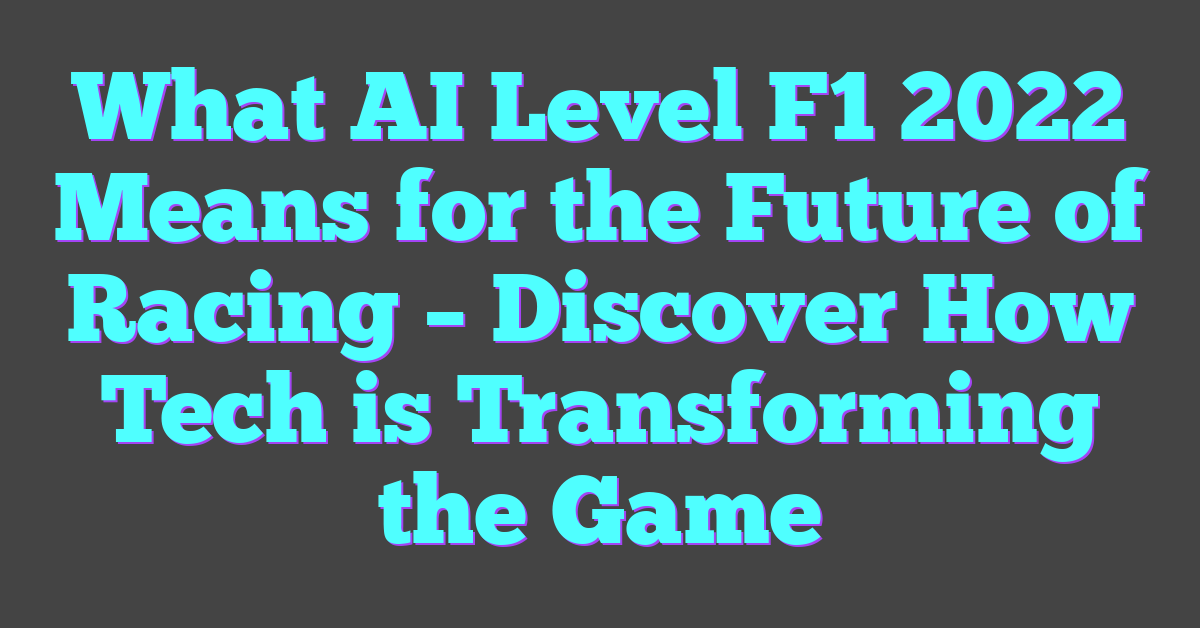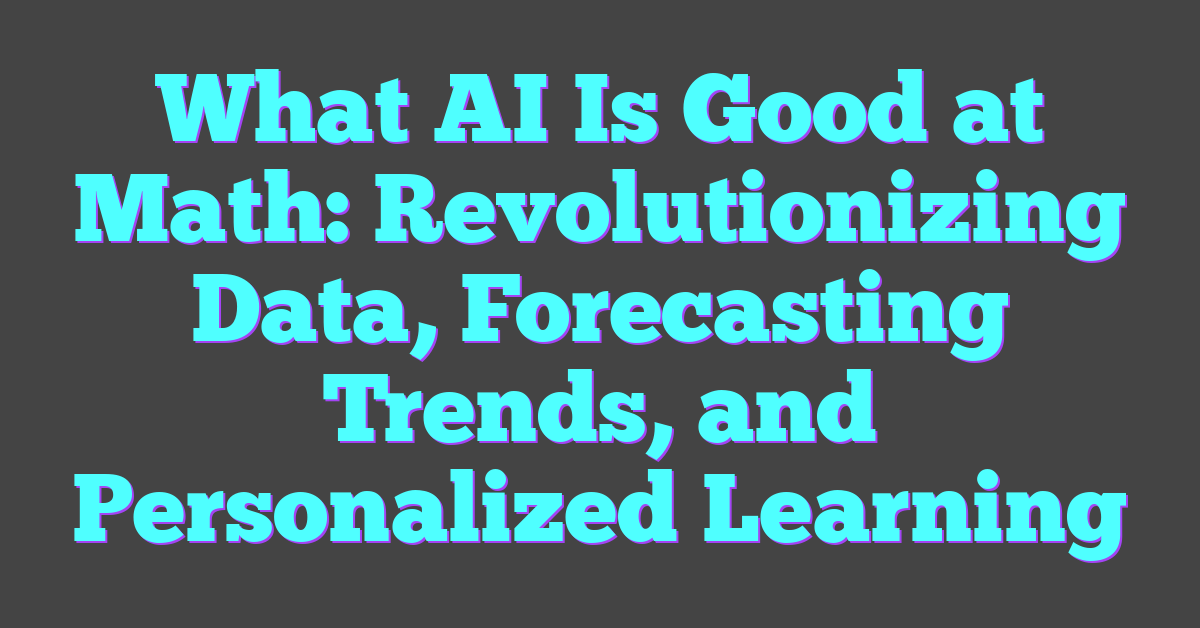Artificial intelligence has made remarkable strides in recent years, transforming how we interact with technology. One fascinating application is Character AI, a tool that brings virtual characters to life with unprecedented realism. But what kind of AI model powers these dynamic personalities?
Understanding the technology behind Character AI can demystify how it creates such engaging and lifelike interactions. Whether you’re a tech enthusiast or just curious about the magic behind your favorite virtual characters, diving into the AI model they use offers a glimpse into the future of digital interactions.
Overview of Character AI Technology
Character AI leverages advanced algorithms to create lifelike digital characters. These characters use AI models to generate realistic, engaging behaviors.

Definition of Character AI
Character AI refers to the use of artificial intelligence to develop virtual characters capable of mimicking human behaviors. These AI characters interact with users through text, voice, or visual mediums. They use sophisticated systems like neural networks to understand context and respond appropriately.
- Natural Language Processing (NLP): Enables the AI to understand and generate human language. Models like GPT-3 often underpin these capabilities, allowing characters to hold meaningful conversations.
- Machine Learning (ML): Drives the learning process, adapting the character’s responses based on user interactions. Techniques include supervised learning, unsupervised learning, and reinforcement learning.
- Neural Networks: Serve as the backbone for processing complex data. Multi-layered neural networks help in capturing subtleties in language, emotion, and context.
- Behavioral Models: Simulate human-like responses by integrating data on human behavior patterns. These models ensure the AI reacts naturally to various scenarios.
- Voice Synthesis: Converts text responses into human-like speech. Technologies like Wavenet generate voices that sound natural and emotive.
By understanding these components, it’s easier to appreciate how Character AI systems create engaging and realistic interactions.
Understanding AI Models in Depth
Various AI models empower Character AI to create interactive, human-like experiences. These models leverage advanced computational algorithms to enhance character communication and adaptability.
Types of AI Models Used in Character AI
Character AI employs several types of AI models, each contributing unique capabilities:
- Natural Language Processing (NLP): NLP models, like GPT-3 from OpenAI, help characters understand and generate human language. They process user inputs and produce coherent responses, enabling fluid conversation.
- Machine Learning (ML): Supervised learning algorithms train characters on large datasets. They learn from past interactions to improve response accuracy over time. For instance, classification algorithms identify themes in conversations.
- Neural Networks: These models, particularly deep neural networks, simulate the human brain’s structure. They’re used for tasks like context comprehension and decision-making, enhancing the realism of interactions.
- Behavioral Models: These models predict human behavior based on input patterns. Reinforcement learning is often applied here, where models learn optimal behaviors through trial and error.
- Voice Synthesis: Text-to-speech models, such as WaveNet by DeepMind, convert text into natural, human-like speech. They provide the auditory element of interactions, making characters’ responses more engaging.
How These Models Enhance Character AI Interactions
These AI models collectively enhance interactions in several ways:
- Context Understanding: NLP and neural networks ensure characters grasp the context of conversations. Awareness of context allows for more relevant and appropriate responses.
- Adaptability: Machine learning algorithms enable characters to adapt based on user data. With each interaction, characters refine their responses, becoming more personalized and accurate.
- Realism: Behavioral models and neural networks contribute to lifelike interactions. Characters exhibit behaviors and decision-making processes similar to humans, increasing immersion.
- Engagement: Voice synthesis models enhance engagement by adding a vocal layer to interactions. Users find characters more relatable and engaging when they can “hear” responses.
- Consistency: Machine learning ensures consistent performance. As characters learn from user interactions, they maintain coherence and reliability in conversations.
Understanding these models offers insight into the sophisticated mechanisms driving Character AI, showcasing the cutting-edge developments in artificial intelligence and machine learning.
Applications of Character AI
Character AI technology revolutionizes multiple sectors by creating digital characters with human-like interactions. These applications span entertainment, gaming, customer service, and chatbots.
Entertainment and Gaming
Character AI enhances user experiences in entertainment and gaming. Video game developers use AI-driven characters to deliver adaptive and immersive gameplay, creating a dynamic environment. For instance, NPCs (non-playable characters) driven by AI can respond to player actions and offer personalized interactions, heightening the reality of virtual worlds. In the film industry, digital characters powered by AI bring lifelike performances that augment visual storytelling.
Customer Service and Chatbots
Character AI elevates customer service by powering intelligent chatbots. These chatbots handle inquiries, offering quick and accurate responses. Businesses use AI-driven characters to provide 24/7 support, reducing wait times and improving customer satisfaction. Moreover, these chatbots can process natural language, understand context, and offer tailored solutions, making interactions seamless and efficient.
Challenges and Future Directions
Character AI technology continues to advance, though it faces several challenges. These challenges affect the performance and potential of Character AI models and drive considerable research in artificial intelligence and machine learning.
Current Limitations of Character AI Models
Scalability, crucial for handling large data volumes, remains a significant challenge. Current models often struggle to maintain accuracy when processing vast amounts of information, leading to performance bottlenecks. Algorithms, essential for natural language processing (NLP) and machine learning (ML), require extensive optimization to handle real-world applications effectively.
Data Quality, impacting model training, varies widely. Poor-quality data leads to inaccuracies in character behavior and responses. Ensuring consistent and high-quality data can be labor-intensive and time-consuming, impacting development cycles.
Context Understanding, vital for nuanced interactions, is complex. While models can handle straightforward queries, they often fail in scenarios needing deep contextual awareness, leading to unnatural or irrelevant responses.
Ethical Concerns, such as bias and privacy, are prominent. Character AI models trained on biased data may reinforce existing prejudices. Additionally, handling user data responsibly is crucial to maintaining trust and integrity in AI applications.
Predictions for Future Developments
Advancements in algorithms and hardware can address scalability issues. Emerging technologies like quantum computing might offer solutions that conventional models lack. More efficient algorithms can process extensive datasets without compromising performance.
Improved Data Management techniques can enhance data quality for training. Automated data cleaning and generation tools may ensure consistently high-quality datasets, reducing labor costs and improving model accuracy.
Enhanced Contextual Understanding should become a focus. Integrating advanced NLP techniques and leveraging contextual embeddings can help models understand and respond to complex, nuanced interactions more accurately.
Ethical AI development practices, with robust frameworks for bias detection and mitigation, will be crucial. Ensuring transparent, ethical AI practices will build user trust and create responsible AI character models.
Incorporating these improvements, Character AI can advance, offering more scalable, accurate, context-aware, and ethical solutions.
Conclusion
Character AI is making waves across various industries by creating more engaging and lifelike digital interactions. With advances in NLP, ML, Neural Networks, Behavioral Models, and Voice Synthesis, these AI models are setting new standards in realism and adaptability.
Despite facing challenges like scalability, data quality, and ethical concerns, ongoing advancements are promising. Future developments in algorithms, hardware, and ethical practices are set to address these issues, paving the way for even more sophisticated and trustworthy AI characters.
As technology evolves, the potential for Character AI continues to grow, offering exciting possibilities for more personalized and human-like digital experiences.
Frequently Asked Questions
What is Character AI technology?
Character AI technology refers to the use of artificial intelligence to create lifelike digital characters. These characters can mimic human behaviors and interactions through various AI models like Natural Language Processing (NLP), Machine Learning (ML), Neural Networks, Behavioral Models, and Voice Synthesis.
What are the key AI models used in Character AI?
The main AI models used are Natural Language Processing (NLP), Machine Learning (ML), Neural Networks, Behavioral Models, and Voice Synthesis. These models help in understanding context, adapting to scenarios, and providing realistic and engaging interactions.
How is Character AI revolutionizing different sectors?
Character AI is transforming sectors such as entertainment, gaming, customer service, and chatbots. It enhances interactions by offering human-like conversations and personalized experiences, making services more engaging and efficient.
What are the primary challenges faced by Character AI technology?
The main challenges include scalability issues, variations in data quality, complexities in context understanding, and ethical concerns such as bias and privacy. These problems need to be addressed for the technology to advance further.
How can scalability issues in Character AI be addressed?
Scalability issues can be tackled by improving algorithms and enhancing hardware capabilities. This allows Character AI systems to handle larger datasets and more complex interactions efficiently.
Why is data quality important in Character AI, and how can it be improved?
Data quality is crucial for accurate and realistic Character AI interactions. It can be improved through better data management techniques, ensuring that the data used for training models is diverse and representative.
What advancements in NLP are expected to improve Character AI’s contextual understanding?
Future advancements in NLP will focus on enhanced contextual understanding, enabling Character AI to grasp and respond to more complex and nuanced human interactions seamlessly.
What ethical concerns are associated with Character AI?
Ethical concerns include bias in AI models, privacy issues, and the potential misuse of AI technology. Addressing these concerns is vital for developing ethical AI practices that build user trust.
What does the future hold for Character AI technology?
The future of Character AI includes advancements in algorithms and hardware, improved data management, better context understanding through advanced NLP, and a focus on ethical AI development. These improvements aim to make Character AI more scalable, accurate, context-aware, and ethical.




